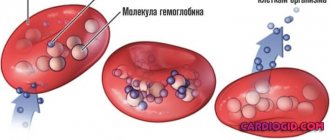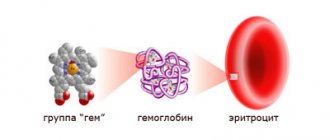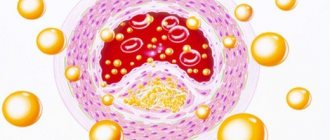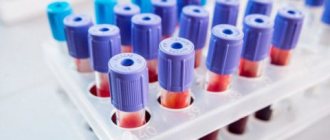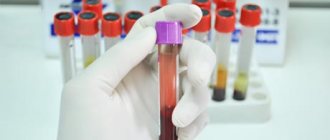How much blood is in the human body
The approximate blood volume is a rather imprecise figure and may fluctuate depending on various factors.
Gender, age, physical fitness, nutrition, pregnancy (in expectant mothers the volume is higher due to the common circulatory system with the child) greatly influence the average. The exact total amount is measured by injecting radioactive isotopes into the body and counting the red blood cell count. According to research, the average numbers are:
- for men – 5-6 l;
- for a woman – 4-4.5 l;
- in children (8-10) years old – 2-2.5 l;
- in older people – 4-5.5 liters.
How to calculate blood volume yourself
But still, these figures are very approximate. After all, the volume of blood in the body depends mainly on a person’s weight, and these calculations are made on the basis of average data. How to find out your number yourself? To do this, you don’t have to go to the clinic - just know your weight and make simple calculations.
So, let's say the weight is 60 kg. The normal percentage of the ratio of blood volume to body weight is from 6 to 9. First, we calculate based on the extreme indicators. At 6% it is 3.6 liters, and at 8% it is 5.4 liters. We add up the resulting values and divide by 2 - we get 4.5 liters. This is the average blood volume, which can fluctuate depending on various factors.
You can go another way. The average blood content per kg of weight is 70-75 ml/kg for men, 60-65 ml/kg for women. We multiply this figure by our weight, we get the volume in ml, which must be divided by 1000. But the method does not really matter - the numbers will be approximately equal.
Safe volume for life
Ordinary cuts or scratches are not dangerous to human life. Only small vessels are damaged - capillaries, violations of the integrity of which are quickly eliminated by platelets. The only threat is blood loss from large vessels - arteries and veins.
Moderate blood loss
Since almost half of the blood is in reserve, a loss of up to 30% of the total circulating blood volume is not considered life-threatening. Losing a third of the blood volume can cause sweating, nausea, dizziness and other unpleasant symptoms - but the person will remain alive. In such a situation, it is recommended to drink a lot to replenish the volume of circulating blood - a transfusion from a donor is usually not required.
Massive blood loss
When a person loses from 30 to 50% of his blood volume, this is more serious. A person's skin turns pale, the body becomes cold, and the limbs become bluish from lack of oxygen. In such a situation, an urgent blood transfusion is necessary - otherwise loss of consciousness or falling into a coma is possible. Losing 50% of volume is already fatal; few people experience this. Survival under such circumstances is possible only if emergency medical care is provided. Death occurs if more than 4 liters (60%) were lost during bleeding.
A person's blood volume is an important indicator affecting health. Severe bleeding is extremely dangerous, especially if major arteries or veins are damaged. Therefore, in such a situation, it is necessary to stop blood loss with a tourniquet and call doctors. Be sure to look for instructions on how to help people with heavy bleeding. Later, such skills can save someone's life.
Contraindications to donation
As you can see, there are many advantages to donating blood. However, before you read further to find out how much blood you can donate to a donor, it is better to determine whether you have any contraindications for this, so that when you arrive at the donor center you will not be refused. So, you cannot donate biomaterial to the following persons:
- whose weight is less than 50 kg;
- whose age is less than 18 years;
- with a heartbeat of more than 55-100 beats per minute;
- with high or low blood pressure;
- suffering from or recently suffered from a serious illness;
- who have had tattoos or had their teeth treated in the last year;
- in contact with persons suffering from infectious or viral diseases;
- pregnant and lactating women, as well as women during menstruation and PMS.
Benefits of donation
Many, for one reason or another, had to act as a donor and donate their blood or plasma, some had their own reasons for this, while others simply do this for charity for the sake of sick children. Of course, you won’t be able to just come to the blood transfusion center without an appropriate examination; first you will need to see doctors such as:
- Therapist.
- Venereologist.
- Dermatologist.
Only after you receive permission from each specialist, you can become a donor, and it does not matter whether you weigh 50 or 60 kg, the volume of red liquid taken will not exceed 450 ml - this is the indicator that will not affect the functions of the body. All new arrivals are necessarily checked against the database, and those who have recently suffered from certain diseases may not be admitted at all
Red liquid is donated no more than once a month, but plasma is allowed to be donated twice. The blood collection procedure takes no more than ten minutes, there is nothing complicated about it. If you come to donate plasma, you will have to lie on the couch for at least thirty minutes.
If you have the opportunity to donate blood or plasma for adults and children in need, take advantage of it, because donation can save the lives of most of them. Some people believe that donation is a life-threatening procedure; in fact, this is not the case; you can verify this by consulting a doctor.
Safe minimum
How many liters of blood should a person have so that there is no threat to life? It is believed that if a person loses 2-3 liters, he dies. This can happen for many reasons. Among them are sudden and heavy bleeding, operations and the postoperative period, treatment of various diseases, hemodialysis.
To save lives, in medicine they often resort to the procedure of donor transfusion. A person who donates his blood to help others is called a donor. It is believed that the one-time safe volume that is taken from him is 450 ml of blood, and plasma - 600 ml. You can donate plasma no more than 2 times a month, and blood no more than 1 time a month.
During this time, the quantitative and qualitative blood composition is completely restored. Each institution that collects donor blood compiles its own database. There are a number of diseases for which it is contraindicated to be a donor. To identify such facts, everyone's blood is taken for a special analysis.
What to do if bleeding starts
If bleeding develops, you must immediately call an ambulance. Before her arrival, the patient is given first aid.
If there is bleeding from the stomach, it is necessary to put cold on the stomach, provide complete rest to the victim, and give him cold water to drink in small sips.
If you have a nosebleed, you should tilt your head slightly forward and apply cold water to the bridge of your nose. You can't throw your head back.
In case of injuries to the extremities with arterial bleeding (scarlet blood flows out under pressure - “spouts”), a tourniquet should be applied or the artery should be pressed with fingers to the bone above the bleeding.
The tourniquet should be applied to fabric, not bare skin. The time for applying the tourniquet must be recorded! In winter, the tourniquet can be kept for no more than 50 minutes, in summer – 1.5 hours. After this time, the tourniquet should be loosened for 5-10 minutes. If necessary, it is applied again, above the previous place of application.
Venous bleeding is stopped by applying a tight bandage to the wound.
For reference. The main treatment is carried out in a hospital. The cause of blood loss is eliminated, depending on the severity of blood loss, infusion therapy is carried out to correct hypovolemia, restore blood volume, balance electrolytes, relieve arrhythmias, restore kidney function, etc.
According to indications, the patient is transfused with solutions of crystalloids, colloids, erythromass, albumin preparations, etc.
What not to do and what to do before donating blood
And now you are already ahead of the curve that you have no contraindications to blood donation. How many times can you take it? Does this question concern you? But this is already understandable. However, let's first find out what not to do before going to the donor center in order to avoid donating bad blood, which not only will not save the life of another person, but, on the contrary, may worsen his situation.
- Two hours before the procedure you should not smoke.
- Two days before donating blood, you should not drink alcohol.
- From the evening until the procedure, you should not eat fatty, spicy, smoked, or fried foods, as well as dairy products, eggs, bananas, chocolate and butter.
- Three days before the procedure, you should not take medications that contain analgesics.
But instead, the day before going to the donor center, you should start drinking a lot of regular water, and in the morning on the day of donating blood, you will need to have a snack of sweet oatmeal with water without butter or a regular bun with sweet tea.
Extraordinary mechanism
The science of hematology is the study of all processes occurring in the blood. She studies how red blood cells are formed, what diseases exist, methods of combating them, and much more.
Experts have proven that human blood volume is only 6-8% of the total body weight. For example, if the weight is 60 kilograms, then there should be about 4.8 liters of blood.
But for more accurate calculations in medicine, there are formulas. To calculate the volume for women, you need to multiply 60 milliliters by her body weight. For men it’s the same, only we multiply 70 milliliters by his weight.
In addition, how much blood a person has depends on age, gender, health status and individual characteristics. Children have less blood tissue than adults. At birth, the child’s blood volume is 14.5% of the weight. As you get older, the level decreases, and in adolescence the levels reach the size of an adult. The average level for men can reach up to 7 liters, for the opposite sex up to 4.5. The content of red blood cells, and therefore hemoglobin, in the blood of men is much higher than that of women. Therefore, with constant transportation of oxygen, they can withstand loads longer. Such characteristics remain throughout life. Blood mass changes with injury, exercise, hard work, and pregnancy. Its quantity will decrease.
If large vessels of the brain are damaged, a loss of 200-300 grams can cause death. After all, 730-750 milliliters of blood flows through them in one minute. With a sharp decrease in blood volume, blood pressure decreases, anemia and necrosis develop. However, with slow blood loss, replenishing it with fluid, a person can lose up to 70% of blood volume and not die. As a rule, having lost half the volume in a short period of time, 98% of people die. The opposite situation also happens when excess blood can form in the body. Then it is distributed into muscle tissue, skin, and from there, processed by the kidneys, it is excreted naturally.
Functions
Before we figure out how many liters of blood are in a person, let's take a look at the main functions it performs. With its help, the most important processes are carried out in the body of an adult and a child. It endlessly, throughout life, circulates through labyrinths of small and large blood vessels that penetrate every organ and system, with the exception of the epithelial layer of the skin and mucous membranes, as well as nails, hair, the cornea of the eye and articular cartilage.
The main task of red cells is to deliver oxygen to tissues due to the ability of hemoglobin to reversibly bind to its molecular structure. Thanks to platelets, blood clotting occurs during bleeding: they quickly overtake the area of damage to the vessel and form a blood clot in this place. As for leukocytes, they are the main defenders of the body from external and internal pathogenic agents.
With the help of blood, oxygen is transported from the lungs to tissue cells, to carbon dioxide, on the contrary, from tissues to the lungs, it transports biologically active components, enzymes, hormones, nutrients, metabolic products, and also performs the function of delivering final products to the organs of the excretory system . It maintains water and electrolyte balance in the body and also regulates body temperature.
Blood performs essential functions in the human body. It constantly circulates in a system consisting of large and small blood vessels that penetrate all organs and tissues, with the exception of the epithelium of the skin and mucous membranes, articular cartilage, cornea, hair and nails.
Red cells deliver oxygen to tissues due to the ability of hemoglobin to reversibly bind to its molecules. Platelets are directly involved in coagulation during bleeding: they rush to the site of vessel damage and form a blood clot at this site. Leukocytes are the body's main defenders from internal and external harmful agents.
Blood transports oxygen from the lungs to tissue cells, and carbon dioxide from tissues to the lungs, carries metabolic products, nutrients, hormones, enzymes, biologically active substances, and is also responsible for the delivery of final metabolic products to the organs of the excretory system. It regulates temperature and maintains water, electrolyte and acid balance in the body.
Blood loss and consequences
The human body is prudent, and not all blood constantly circulates in the human body, performing its functions. The body also has so-called blood depots (reserves), where it is stored in case of special need. Blood is stored in the spleen, liver, and a number of other organs, and with heavy blood loss, as well as in stressful situations, it can be released into the general bloodstream. However, even this reserve may not be enough if we are talking about severe bleeding and large blood losses. This applies primarily to arterial and severe venous bleeding. Every person should be able to recognize them in order to be able to help themselves and their loved ones if necessary.
For arterial bleeding, which is especially dangerous and can lead to death. In this case, it is necessary to apply a tourniquet and immediately hospitalize the person. The tourniquet can only be applied for 2 hours, in cold weather - no more than an hour, otherwise there is a risk of necrosis and limb loss. In case of venous bleeding, when dark blood flows in a continuous stream, it is necessary to apply a pressure bandage and also consult a doctor.
Chronic blood loss
In addition to such bleeding, which usually occurs due to injuries, there is another category - chronic blood loss. They occur during oncological tumors, ulcers, hemorrhoids and other phenomena. Symptoms develop gradually, because the body initially strives to compensate for losses. This phenomenon leads to anemia, constant fatigue and loss of strength, dizziness, pallor, and problems with the immune system. It is necessary to establish the cause of these disorders and undergo treatment, after which the blood condition will improve.
Blood is the most important fluid in the body, and it contains from 3 to 5 or more liters. But losing more than 30 percent of blood is fraught with serious consequences. It is worth taking care of your health and not risking it.
Composition of blood and the volume of its various components in the body
Blood plasma
Blood is not homogeneous; it contains both individual formed elements and liquid plasma. The latter forms 52-58 percent of the blood, and the rest is formed elements, including various blood cells. Plasma, in turn, is 90 percent water, and 10 percent of its composition is dry matter. The percentage of formed elements to plasma, called hematocrit by doctors, is slightly higher in men than in women. And these indicators are relatively even in nature, without changing significantly in the norm.
Interesting: Why do canned foods spoil?
Blood plasma composition
Composition of blood plasma
The dry residue of plasma consists of many useful and necessary substances for the body. These are proteins and non-protein nitrogenous elements, enzymes and proenzymes, as well as non-nitrogenous organic matter, and much more. Any changes in blood composition affect the functioning of organs and systems, a person’s well-being, and this applies to even minor changes.
Why does blood thickening occur?
Blood thickening, that is, a decrease in the percentage of plasma in relation to other components, usually occurs against the background of severe dehydration of a person, and this is a deadly phenomenon. In this case, the cardiovascular system begins to experience severe overloads, kidney function is disrupted, thrombus formation and other processes can begin that can lead to the rapid death of a person.
How many liters of blood are there in a person
It is believed that if a person loses half of all the blood contained in the body, he will die. But even small losses have their consequences. Most often these changes are negative
Without significant harm to the body, you can lose about fifteen percent of this vital fluid. Of course, taking into account the absence of serious chronic diseases, intoxication or other abnormalities that impair and slow down subsequent recovery
The age of the victim is also important here: young children tolerate bleeding very poorly. Just like older people, who often develop clotting problems with age. In addition, it was found that in hot weather, blood loss is tolerated by the human body much worse than in cool months.
How many liters of blood are there in a person? Total number and possible differences among different groups of people
Answering this question, we can only talk about the approximate volume. So how many liters of blood is there in an average person? On average, the mass of this liquid is from six to eight percent of the total weight. The amount of blood in the body of each person varies, including depending on gender. Despite the fact that a woman has about 4-4.5 liters of this fluid, and a man has 5-6, which is much more, the weaker sex tolerates its loss more easily. Interestingly, the main reason why men are able to better tolerate various physical activities also lies in the composition of the red liquid. Unlike women, the blood of the opposite sex has a higher content of hemoglobin and red blood cells. This allows you to quickly saturate the body with oxygen.
Donation and symptoms of blood loss
When asked how many liters of blood can be taken from a person for medical purposes, doctors give slightly different numbers. But on average, 450 grams are taken from donors. this liquid. The person does not experience any particular discomfort. But a loss of 20 to 40 percent is already considered large. It is characterized by cardiac dysfunction, tachycardia and a strong decrease in blood pressure. Outwardly, this manifests itself in obvious pallor, rapid breathing, and cold extremities. Victims usually complain of dizziness, and even fainting is possible. The loss of more than 70 blood circulating in the body causes convulsions, agony, and leaves virtually no chance for anyone to survive.
It is also important how long the human body loses blood. A rapid loss of two to three liters is fatal, although it, only distributed over a longer time, will not lead to death
Large and frequent blood losses can ultimately lead to anemia. Of course, if we are not talking about donation: in the hospital they will take only a minimal amount from you (as already said, harmless to health).
If you have lost no more than 30 percent of your blood, a transfusion is not required. It will be enough for the victim to provide timely assistance and give time to recover. Drinking small amounts of red wine or pomegranate juice can help this process. Drinking tea mixed with milk and adding garlic to food also have a good effect on replenishing the blood balance in the body. Here you should definitely add products such as raisins, many fruits, especially those rich in iron, red fish, dried apricots and nuts. Frequent drinking is recommended. Full recovery is usually achieved within two weeks.
You need to know: in order to satisfy your curiosity and find out how many liters of blood are in a person, you should understand what kind of blood is meant by this question. The one that the body is capable of losing in case of serious injury? But it exists not only in free form. Distilling substances and circulating through the circulatory system, red liquid makes up only about 70%. A certain amount of it is constantly found in the muscles, kidneys and liver. And also in the human brain.
Does it matter how many liters of blood a person has? It is important, although there are more serious indicators, especially since its amount varies depending on weight. The above five liters is an average
The amount of blood in a person with a large physique can reach up to ten. Even when we talk about anemia, we do not mean a small volume of red liquid. In general, how many liters of blood a person has does not characterize his state of health. Its composition is more important. Namely, the number of red cells (erythrocytes). After all, it is known that the blood circulating through our body is nothing more than a transparent liquid with impurities dissolved in it. Otherwise, this substance is called plasma. And it is the red blood cells that give it its characteristic color.
How many blood types does a person have?
1st group:
It is generally accepted that this blood group appeared first. The group of “hunters,” as it is also called, flowed in the veins about 60,000 years ago among the Neanderthals and Cro-Magnons - the ancestors of humans who only knew how to hunt and gather food. People with this blood type have leadership qualities.
Group 2:
Appeared later than the first one. During the period when people began to master the basics of agriculture. This was between 25,000 and 15,000 BC. This blood type is typical for the inhabitants of the European continent. People with group 2 are leaders by nature, however, unlike people with group 1, they know how to establish contact with others.
Group 3:
The appearance of the 3rd group was marked about 17,000 years ago, along with the settlement of people in the northern regions with a cold climate. The first owners of the 3rd blood group are the Mongoloid race. Today such a group predominates in Asia and Eastern Europe. Those in whose veins such blood flows are patient and diligent.
Group 4:
The rarest and newest of all the others. Its appearance is believed to have occurred about 1000 years ago as a result of the mixing of Indo-Europeans, carriers of group I, and Mongoloids, carriers of group III.
Previous article: Interesting Facts about Manatees Next article: Diamond Color and Clarity
Blood functions
How many liters of blood a person has is determined in accordance with his individual characteristics and the functions performed by the fluid. Blood constantly moves through the system, which includes large and small vessels. They supply fluid to all organs and tissues in the human body.
Red cells deliver oxygen to tissues as hemoglobin binds to its molecules. Platelets are involved in the coagulation process during bleeding. With their help, a blood clot is formed at the site of injury. Thanks to leukocytes, protection is provided from the effects of negative external and internal factors.
Prolactin - what is it, its function and norm in the body
Blood has a positive effect on kidney function. It also helps transport oxygen from the lungs to the tissues. Carbon dioxide travels from tissues to the lungs with liquid. Thanks to the liquid, an even distribution of hormones, nutrients, biologically active substances and enzymes is ensured. Thanks to the liquid, the delivery of the final products of metabolic processes to the excretory system is ensured. With its help, water and electrolyte balance is maintained, as well as temperature regulation.
Basic composition of blood
How many liters of biofluid a person has directly depends on various indicators, which include age, weight and gender. An adult contains from 5 to 6 liters of fluid. The composition of blood includes its liquid part - plasma and suspended formed elements: red blood cells, platelets and leukocytes. Formed elements are contained in a ratio of 40 to 45 percent, and plasma - from 50 to 60 percent.
The amount of blood in a middle-aged person ranges from 4.5 to 5.5 liters. Blood ratios are also determined according to body weight. A person who weighs 50 kilograms has an average of 3-4 liters. With a weight of seventy kilograms, the content is from 4.2 to 5.6 liters.
How many liters of blood are there in an average person?
The answer to the question of how much blood a person has is based on the assumption that the blood volume of an adult is 5–9% of his total body weight. Thus, the student’s answer should be clarified. An adult man has an average of 5–6 liters of blood in his body, while a woman has approximately 4–5 liters.
Moreover, blood is unevenly distributed in the body. So, 50% of its volume falls on the muscles and kidneys, 13% on the lungs, 10% on the liver, 8% on the brain, and the rest on the heart and intestinal vessels.
Doctors know more accurate ways to determine the volume of blood in each individual body. The two most common are:
A harmless dye is injected into the blood.
Thanks to the circulatory system, it spreads throughout the body.
After this, blood is taken for analysis and the concentration of the dye is determined.
Based on the data obtained, the blood volume of a given person is calculated.
A radioactive substance is injected into the blood.
Then, based on tests, they look at how much of this substance is in red blood cells. Next, they create a proportion that shows how much blood is in the body.
Knowing what the volume of blood is is not necessary to satisfy abstract curiosity. There are a number of diseases in which blood volume and the number of red blood cells decrease or increase. In addition, this information is necessary during surgical operations.
Time to remove alcohol from the blood
As we have already established, one ppm corresponds to one milliliter of alcohol in one liter of blood. Thus, with the same amount of alcohol consumed, the person who has more blood in the body will have a lower value. That is, the greater the mass, the less alcohol in the blood. Below is a calculation table, the so-called alcohol calculator, based on which you can determine how much time must pass after drinking alcohol before you can drive.
| Amount drunk, ml | Human weight, kg | ||||
| beer 4%…5% | |||||
| 3 hours | 2.5 hours | 2 hours | 2 hours | 1,5 hour | |
| 6 hours | 5 o'clock | 4.5 hours | 4 hours | 3.5 hours | |
| 9 o'clock | 7.5 hours | 6.5 hours | 6 hours | 5 o'clock | |
| champagne 9%…11% | |||||
| 1,5 hour | 1,5 hour | 1 hour | 1 hour | 1 hour | |
| 5 o'clock | 4 hours | 3.5 hours | 3 hours | 3 hours | |
| 8 ocloc'k | 7 o'clock | 6 hours | 5 o'clock | 5 o'clock | |
| dry, semi-dry wine 11%…14% | |||||
| 2 hours | 2 hours | 1,5 hour | 1,5 hour | 1 hour | |
| 10 hours | 9 o'clock | 8 ocloc'k | 7 o'clock | 6.5 hours | |
| 14 hours | 12 hours | 11 o'clock | 10 hours | 9 o'clock | |
| tincture, liqueur 25%…30% | |||||
| 4 hours | 3.5 hours | 3 hours | 2.5 hours | 2 hours | |
| 10 hours | 8 ocloc'k | 7 o'clock | 6 hours | 5 o'clock | |
| 20 hours | 17:00 | 15 hours | 13 hours | 11 o'clock | |
| vodka 40% | |||||
| 6 hours | 5 o'clock | 4.5 hours | 4 hours | 3.5 hours | |
| 14 hours | 12 hours | 11 o'clock | 10 hours | 9 o'clock | |
| 29 hours | 25 hours | 22 hours | 19:00 | 17:00 | |
| whiskey, cognac 42%...43% | |||||
| 6 hours | 5.5 hours | 5 o'clock | 4.5 hours | 4 hours | |
| 15 hours | 13 hours | 11 o'clock | 10 hours | 9 o'clock | |
| 31hours | 26 hours | 23:00 | 21 o'clock | 18 hours | |
But we must not forget that the calculation of alcohol in this table to determine the permissible dose of alcohol while driving is very arbitrary and depends on many factors.
Use the consultation: Are you sure that the permissible level of alcohol for water is 0.2 ppm?
Methods for determining the amount of blood in the body
Colloidal solution
To determine the volume of blood, a special dye is injected into the blood vessels, which is absolutely harmless to the body. Next, wait a while until the substance is evenly distributed throughout the blood. After this, a portion of blood is taken for analysis, where the concentration of the administered substance is determined. Based on the amount of fluid administered, the total volume of blood in the body is calculated.
Radioactive tracers
In this case, blood is taken from a person, and then the red blood cells are separated from the plasma. Next, the red blood cells are placed in a solution containing radioactive phosphorus. The “tagged” red blood cells are then injected back into the person. After the substance is distributed, blood is taken again for analysis and the total amount of blood is calculated computationally based on the concentration of the radioactive substance.
Human blood: composition
Blood is a liquid that is vital to the body.
Thanks to the blood, tissues and cells receive oxygen, and the lungs and kidneys remove unnecessary substances from the body.
It connects various organs and systems with each other and protects against infections.
It determines body temperature, pressure and how the genitals work.
Not every student can answer the question of what blood consists of. 60% from plasma. This substance is 99% water, but without it the formation of blood in the body is impossible.
Human blood is mostly composed of plasma. Red blood cells carry oxygen and make this liquid red. Platelets carry out blood clotting, and with the help of leukocytes, the body fights all kinds of infections. Moreover, the composition of the blood may change. The main reason for this is human disease.
Basic composition of blood
Blood plasma
Blood plasma composition
Blood plasma composition
How to make up for the loss?
Compensated blood loss is considered to be a decrease in circulating blood volume by ten to fifteen percent. Such patients have normal or moderately low blood pressure, a compensatory increase in heart rate and slight weakness.
For reference. Moderate blood loss is considered to be a decrease in the amount of blood by fifteen to thirty percent.
Such blood loss manifests itself:
- decrease in pressure,
- weakness,
- thirst,
- heart rhythm disturbances and compensatory tachycardia,
- sweating,
- increased breathing,
- dizziness.
With a loss of thirty to thirty-five percent of circulating blood volume (CBV), moderate blood loss is noted. Patients are restless, there is severe pallor, blueness under the eyes, impaired skin turgor, profuse sweating, cyanosis, a sharp decrease in pressure, impaired renal function, arrhythmias, and significant tachycardia.
Attention! The loss of more than forty percent of blood is accompanied by severe shock with the development of multiple organ failure. For an adult who does not have concomitant pathologies, blood loss of up to 15% of the blood volume is considered compensated.
For an adult who does not have concomitant pathologies, blood loss of up to 15% of the blood volume is considered compensated.
A loss of more than 35% of blood volume is accompanied by severe disorders and a high risk of death.
Important! For weakened patients, as well as those with heart failure, these rates are lower. The human body is prudent, and not all blood constantly circulates in the human body, performing its functions
The body also has so-called blood depots (reserves), where it is stored in case of special need. Blood is stored in the spleen, liver, and a number of other organs, and with heavy blood loss, as well as in stressful situations, it can be released into the general bloodstream
The human body is prudent, and not all blood constantly circulates in the human body, performing its functions. The body also has so-called blood depots (reserves), where it is stored in case of special need. Blood is stored in the spleen, liver, and a number of other organs, and with heavy blood loss, as well as in stressful situations, it can be released into the general bloodstream.
For arterial bleeding, which is especially dangerous and can lead to death. In this case, it is necessary to apply a tourniquet and immediately hospitalize the person. The tourniquet can only be applied for 2 hours, in cold weather - no more than an hour, otherwise there is a risk of necrosis and limb loss. In case of venous bleeding, when dark blood flows in a continuous stream, it is necessary to apply a pressure bandage and also consult a doctor.
Today this problem is solved with the help of donor blood transfusions. This procedure is necessary for severe injuries, surgeries, and childbirth. Most often, plasma is transfused, which makes up about 60% of the total volume. The donor's blood must match the patient's group and Rh factor.
According to the existing law, you can donate no more than 450 ml of blood (or 600 ml of plasma) at a time. In addition, there are restrictions on the frequency of donation and the weight of the donor (4 times a year for women, 5 times for men, the interval between donations is at least 60 days, the donor’s weight is at least 50 kg). This order is due to the fact that the loss of 10% of blood can lead to a deterioration in health and the development of anemia.
Today, this problem can be solved using donor raw materials. Such manipulation is vital during childbirth, surgery and severe injuries. In most cases, plasma is transfused, which makes up about 60% of the total amount. The donor's plasma must necessarily match the patient's Rh factor and group.
Today there is a law according to which you can donate no more than 450 ml at a time. In addition, there are restrictions on the weight of the donor and the frequency of donation. Within one year, a woman can donate no more than 4 times, and men 5, the interval between samplings must be at least two months, and the donor’s weight must be at least 50 kg. These rules are due to the fact that a loss of 10% of plasma can cause the development of anemia and poor health.
Summarizing all of the above, I would like to note that human health depends not only on the composition of the blood, but also on its quantity. A significant decrease in its amount can lead to the development of various diseases.
Danger of hematocrit imbalance
In case of dehydration (diarrhea, vomiting, etc.), a violation of vascular permeability occurs. As a result, the amount of plasma fraction decreases, which leads to thickening of human blood. This negatively affects the functioning of the entire cardiovascular system, as the load on the latter increases. Often this results in blood clots and kidney damage.
A decrease in the concentration of formed fractions is recorded with bone marrow dysfunction and disruption of its hematopoietic functions. In this case, there is a decrease in blood clotting rates and a violation of the body’s resistance against infections, and a lack of oxygen occurs in tissues and various organs.
A decrease in the number of red blood cells may indicate anemia. A deficiency of red blood cells, and therefore hemoglobin, provokes a disruption in the supply of oxygen to tissues, disruptions in heart rhythm, decreased immune function, general weakness, and problems with hair and nails.
A lack of protein compounds in plasma often manifests itself in the appearance of edema, immune deficiency, as well as malfunction of the liver and kidneys. Electrolyte imbalance manifests itself in the form of muscle spasms, dangerous types of arrhythmia, seizures and acute renal failure. Cases of heart block are common.
Types of blood loss
A reduction in the plasma fraction of blood, as well as its formed elements, occurs with various types of blood loss. All types of blood loss are divided into chronic and acute. The first ones are observed when:
- Prolonged menstruation, characterized by copious bleeding.
- Bleeding from the nose.
- Blood discharge from hemorrhoids.
- Diseases associated with ulcerative lesions of the stomach and duodenum.
- Oncological changes in the body.
- Problems associated with insufficient blood clotting.
As a rule, chronic blood loss always triggers compensation mechanisms. This means that symptoms develop gradually. At the same time, patients are bothered by dizziness, patients often experience decreased vision, drowsiness, hair loss often begins, and the skin becomes dry.
In acute forms of blood loss, the body cannot quickly adapt to a significant decrease in the amount of blood. As a result, in such cases the following develop:
- Hypotension.
- Malfunctions of the heart.
- Hypoxia of organs and tissues of the body.
- Kidney failure.
If the decrease in circulating blood volume (CBV) does not exceed 10−12%, then they speak of compensated blood loss. In such cases, patients usually have normal blood pressure or a moderate decrease in blood pressure.
With moderate blood loss, the amount of blood in the bloodstream decreases from fifteen to thirty percent. The patient develops weakness, heart failure, sweating, and increased breathing.
If the blood volume is 30, but does not exceed 35%, then we can talk about moderate blood loss. The patient's skin becomes pale, blueness appears under the eyes, blood pressure drops sharply, kidney function is disrupted, and tachycardia is significant.
Symptoms of severe blood loss, which occurs with blood volume from 35 to 40%, include: impaired consciousness, heart failure, cyanosis.
Allowable reduction
If a person does not have concomitant diseases, then the compensatory level is considered to be a VOC that does not exceed fifteen percent. With a loss of 35% or more, the patient's condition is characterized by severe impairment, as well as a high risk of death.
For weakened patients, as well as all those who suffer from heart failure, the rates are even lower.
Registration for blood donation
And now you finally come to the hospital to become a donor. However, before we know how much blood you can donate, let's first understand the process of registering and getting approved to donate. Actually, everything is very simple here.
First, you will need to go to the registry and fill out the “Donor Questionnaire” there, honestly answering all the questions. Then the potential donor is sent for a medical examination by a therapist, who will measure his pulse and temperature, examine the mucous membrane and skin.
Blood must be taken from a finger prick to determine the Rh factor and blood group, as well as the hemoglobin level. After this, the transfusiologist analyzes all the available data, asks additional questions if necessary, makes a conclusion whether the person can become a donor of blood or its components, and issues a referral to the buffet for tea and a bun.
How much blood can a female donor donate?
Women have a much harder time recovering from blood donation, so the amount of collected biomaterial is slightly different from that of men. And above all, this concerns the frequency of the procedure, since a woman can donate whole blood only 4 times a year, that is, no more than once a quarter.
The only option when relaxation of these standards is allowed is an urgent need for this type of blood, but in this case, specialists will first conduct a thorough examination of the woman and decide how much she has recovered after the previous collection of biomaterial. The volume of blood donated by women should be on average 370 ml, and should not exceed 450 ml.
Recovery after donation
Now that we have learned how much blood can be donated to a woman and how much to a man, and have completely gone through this procedure, we need to let our body recover after taking the biomaterial. To do this, you must strictly follow the instructions of doctors:
- You need to continue to lie in the donor chair for 10-15 minutes, resting after the procedure and gaining strength;
- if you feel dizzy or nauseous, it is better to consult a doctor immediately so that certain measures can be taken to eliminate these symptoms;
- You should not smoke for at least 2 hours after the procedure;
- Do not touch or wet the bandage at the blood collection site for 3-4 hours;
- During the day you should avoid any physical activity - this day should be spent in a relaxed mode;
- It is not recommended to drink alcohol during the day, with the exception of 100 grams of red wine;
- for two days you should eat properly and regularly and drink more water to restore strength;
- You should not vaccinate for 10 days.
